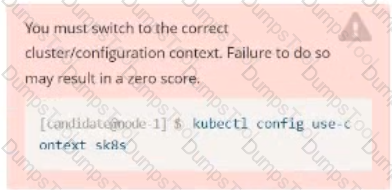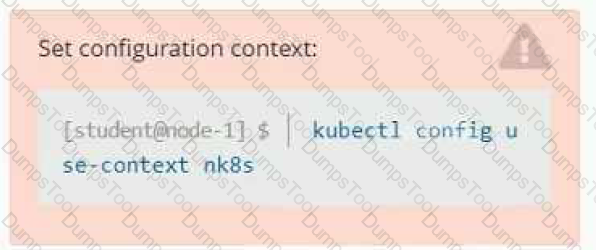Linux Foundation Certification Exam CKAD has been designed to measure your skills in handling the technical tasks mentioned in the certification syllabus

Task
A Deployment named backend-deployment in namespace staging runs a web application on port 8081.


Context
It is always useful to look at the resources your applications are consuming in a cluster.
Task
• From the pods running in namespace cpu-stress , write the name only of the pod that is consuming the most CPU to file /opt/KDOBG030l/pod.txt, which has already been created.
Context
Anytime a team needs to run a container on Kubernetes they will need to define a pod within which to run the container.
Task
Please complete the following:
• Create a YAML formatted pod manifest
/opt/KDPD00101/podl.yml to create a pod named app1 that runs a container named app1cont using image Ifccncf/arg-output
with these command line arguments: -lines 56 -F
• Create the pod with the kubect1 command using the YAML file created in the previous step
• When the pod is running display summary data about the pod in JSON format using the kubect1 command and redirect the output to a file named /opt/KDPD00101/out1.json
• All of the files you need to work with have been created, empty, for your convenience


Task
You are required to create a pod that requests a certain amount of CPU and memory, so it gets scheduled to-a node that has those resources available.
• Create a pod named nginx-resources in the pod-resources namespace that requests a minimum of 200m CPU and 1Gi memory for its container
• The pod should use the nginx image
• The pod-resources namespace has already been created

Task
A deployment is falling on the cluster due to an incorrect image being specified. Locate the deployment, and fix the problem.
Customers Passed
Linux Foundation CKAD
Average Score In Real
Exam At Testing Centre
Questions came word by
word from this dump
DumpsTool Practice Questions provide you with the ultimate pathway to achieve your targeted Linux Foundation Exam CKAD IT certification. The innovative questions with their interactive and to the point content make your learning of the syllabus far easier than you could ever imagine.
DumpsTool Practice Questions are information-packed and prove to be the best supportive study material for all exam candidates. They have been designed especially keeping in view your actual exam requirements. Hence they prove to be the best individual support and guidance to ace exam in first go!
Linux Foundation Kubernetes Application Developer CKAD PDF file of Practice Questions is easily downloadable on all devices and systems. This you can continue your studies as per your convenience and preferred schedule. Where as testing engine can be downloaded and install to any windows based machine.
DumpsTool Practice Questions ensure your exam success with 100% money back guarantee. There virtually no possibility of losing Linux Foundation Kubernetes Application Developer CKAD Exam, if you grasp the information contained in the questions.
DumpsTool professional guidance is always available to its worthy clients on all issues related to exam and DumpsTool products. Feel free to contact us at your own preferred time. Your queries will be responded with prompt response.
DumpsTool tires its level best to entertain its clients with the most affordable products. They are never a burden on your budget. The prices are far less than the vendor tutorials, online coaching and study material. With their lower price, the advantage of DumpsTool CKAD Certified Kubernetes Application Developer (CKAD) Program Practice Questions is enormous and unmatched!
The Linux Foundation CKAD Exam validates your ability to deploy and manage containerized applications using Kubernetes. It assesses your skills in working with pods, deployments, services, secrets, and other core Kubernetes concepts.
The Linux Foundation CKAD exam focuses on hands-on scenarios, testing your proficiency in areas like:
No formal prerequisites exist for the Linux Foundation CKAD exam. However, a foundational understanding of Linux commands and containerization principles is recommended.
The Linux Foundation CKAD exam consists of 19 performance-based tasks (questions).
The Linux Foundation CKAD exam is 2 hours long.
To pass the Linux Foundation CKAD exam, you need a score of 66% or higher.
Here's a breakdown of the key differecne between CKAD and CKA (Certified Kubernetes Administrator) exams:
Dumpstool equips you with a powerful CKAD exam prep toolkit, including:
Dumpstool boasts a user-friendly purchasing process. Simply add the desired CKAD materials (PDF, testing engine or study guide) to your cart, proceed to checkout, and enjoy instant access upon successful payment.
For any support or inquiries regarding the Linux Foundation CKAD exam materials, you can contact Dumpstool through our website’s contact page or live chat. Our customer service team is ready to assist you with any questions or concerns.